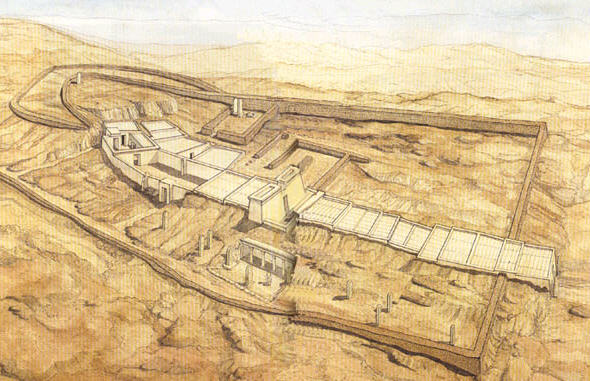The Hathor Temple at Serabit el Khadim in the southern Sinai.
To the south of this temple lie Gebels Serabit el Khadim, Ghorabi and Saniya. I have proposed that Ghorabi might preserve Mount Horeb or the the "rock of Horeb" at Rephidim, and that Rephidim might be Serabit el Khadim, while Mount Sinai might be Gebel Saniya. Proto-Sinaitic stone tablets or stelae have been found in association with Egyptian mining camps in the vicinity of this temple. I understand that Judeans at the Feiran Oasis (Byzantine Pharan, Biblical Paran ?) in the 9th-8th centuries BCE may have visited the Serabit el Khadim area and noting these inscriptions, were inspired to create a story of Israel's worship of the Golden Calf and Moses' destruction of the 10 Commandments. According to Egyptian myths, Hathor the cow-sky-goddess, gave birth to the sun each day as a Golden Calf. Pharaoh in Old Kingdom Pyramid Texts called himself the Golden Calf born of Heaven (Hathor being "heaven" as a sky-cow-goddess), and implored Hor (Greek: Horus) to let him ride every morning the sacred solar bark or boat that carried the sun-god across the heavens. Festivals were held in Hathor's honor involving singing, dancing, drunkeness and even on occasion nudity. Perhaps these Cultic rites associated with Hathor at Serabit el Khadim were transformed into Israel's worship of the Golden Calf? The temple possessed votives to Hathor bearing Proto-Sinaitic inscriptions revealing that the Asiatic miners had no problem eqating Hathor with their gods and goddeses. Perhaps the Asiatic miners honoring of Egyptian gods, Sopdu and Hathor, became transformed into Israel honoring the Golden Calf? The temple began as two caves (to the viewer's left) dedicated to Hathor and Sopdu. Hathor was the goddess of miners who mined Turqouise, Malachite and Copper. She was also the goddess who received the dead into the underworld via a cave in the side of mountain to the west of the Nile. She is frequently portrayed with her head or body emerging from the cave in the western mountain, receving the deadinto the underworld. Sopdu was a warrior-god associated with Per-Sopdu, modern Saft el Henneh in the eastern delta at the west end of Wadi Tumilat. He protected Egypt's eastern roads from invasion by Asiatics, and was called "bull that tramples the Menti nomads of the east." He is portrayed in Asiatic garb.
